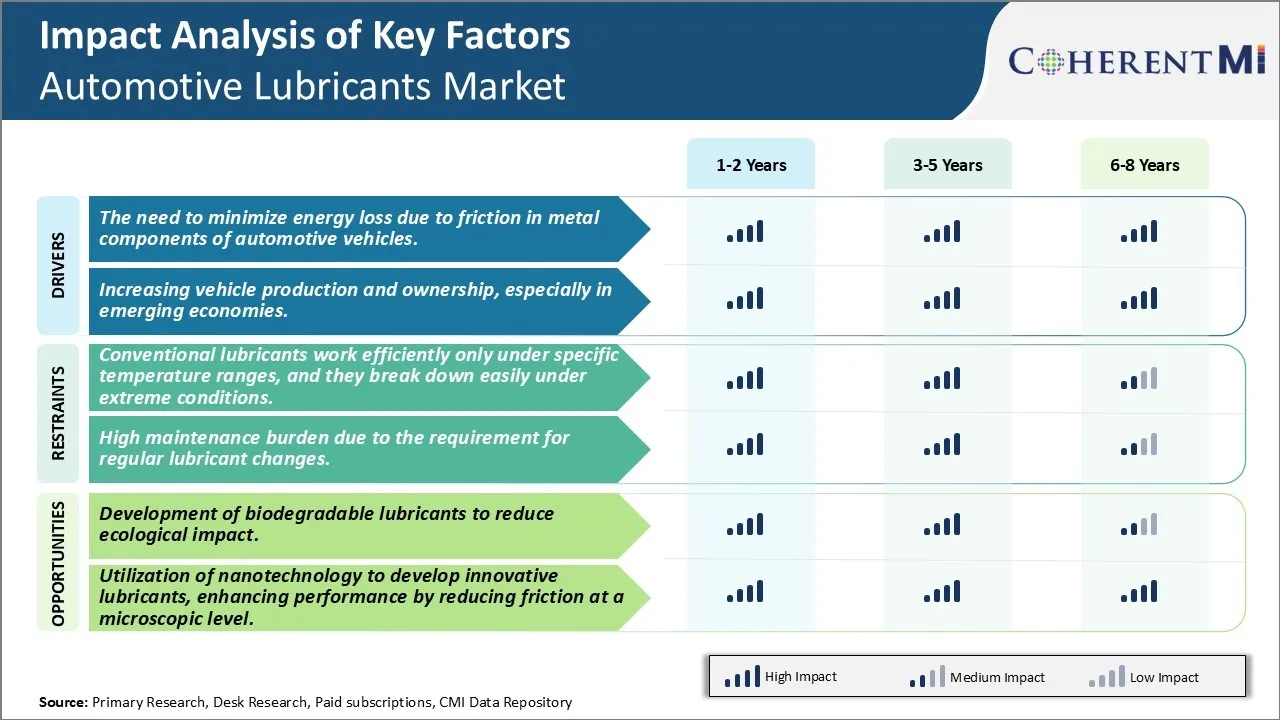Automotive Lubricants Market Trends
Market Driver - The Need to Minimize Energy Loss Due to Friction in Metal Components of Automotive Vehicles
One of the primary drivers for the automotive lubricants market is the need to minimize energy loss due to friction in metal components of automotive vehicles. Friction between moving parts like the engine, gear system and other components leads to wastage of significant amount of energy in the form of heat. It is estimated that around 20% of the energy generated in an internal combustion engine is lost due to friction alone. The use of advanced lubricants plays a crucial role in reducing this friction between surfaces which are in constant contact during motion. Lubricants form a thin protective film that separates the surfaces and reduces the adhesion and friction between them. This film holds the grinding dust and pollutants generated during movement, prevents direct metal to metal contact and allows for the parts to move over each other smoothly. The thinner the film, the lesser is the energy required to overcome friction forces. Lubricant companies have been innovating new lubricant formulations that can provide effective lubrication and reduce friction even at high pressures and temperatures inside modern engines. These low viscosity lubricants not only enhance the fuel efficiency of vehicles but also help extend the lifetime of components that are otherwise prone to premature wear and tear. With rising environmental consciousness, there is a growing demand from both OEMs and consumers for vehicles with higher fuel efficiency. Use of advanced automotive lubricants plays a vital role in improving the efficiency of engines and other components, thereby making them more environment friendly. This drives the market for high performance lubricants that can meet the stringent efficiency and emission norms.
Market Driver- Increasing vehicle production and ownership, especially in emerging economies
Another key driver for the automotive lubricants market is the increasing vehicle production and ownership levels witnessed across the globe, especially in emerging economies. Over the past few decades, personal mobility has risen dramatically in tandem with economic growth and rising disposable incomes in developing nations. Countries like China, India, Brazil, Mexico, and Indonesia have seen massive growth in the number of passenger and commercial vehicles plying on roads. This has directly translated to higher demand for various automotive products including lubricants. Even though the fleet size in developed markets of United States, Europe and Japan have grown at a steady pace, emerging economies now account for the bulk of global vehicle sales. As infrastructure and connectivity improves in these developing regions, personal transport is becoming more accessible causing vehicle ownership to boom. At the same time, local manufacturing of cars and commercial vehicles has also picked up substantially. Both domestically produced as well as imported vehicles require lubricants for various systems like engines, gearboxes and differentials. Regular maintenance and scheduled oil changes ensure a continuous demand from the sizable in-use vehicle parc. Furthermore, growing vehicle usage also accelerates the wear of components, necessitating more frequent oil changes or top-ups. The rising mechanization of industries and growth of e-commerce has augmented demand for commercial vehicles like trucks and buses, further amplifying lubricant consumption. With emerging economies projected to account for over 50% of the global vehicle sales in coming years, automotive lubricant manufacturers can expect sustained volume growth from these markets.

Market Challenge - Conventional Lubricants Work Efficiently Only Under Specific Temperature Ranges, and They Break Down Easily Under Extreme Conditions
Conventional lubricants work efficiently only under specific temperature ranges, and they break down easily under extreme conditions. This poses a significant challenge for the automotive lubricants market. Traditional mineral-based lubricants start to deteriorate and lose their viscosity and film strength properties when exposed to very high or very low temperatures outside their operational range. As modern vehicles are being engineered to perform efficiently even in diverse climatic conditions around the world, the lubricants need to be able to withstand wider temperature variances as well. The engines and transmission components of vehicles often experience temperatures ranging from below freezing point up to 150 degree Celsius during extreme usage. Similarly, conventional lubricants also get increasingly shear thin under high friction and heavy loads. This exposes the internal parts to damage. Therefore, developing lubricants that can maintain their lubricating properties effectively under a broad range of thermal and mechanical stresses is a major challenge for the automotive lubricants industry. New product formulations with advanced additives are being researched to overcome this limitation of conventional lubricants.
Market Opportunities - Development of Biodegradable Lubricants to Reduce Ecological Impact
One of the significant opportunities for the automotive lubricants market is the increasing focus on developing biodegradable and environmentally sustainable products. The disposal and leakage of used conventional mineral-based lubricants pose hazards to the environment as most lubricant components are not readily biodegradable. Stricter environmental regulations globally are now mandating the use of lubricants which are less toxic and can break down naturally after use. Biodegradable lubricants based on esters and bio-based additives offer a solution. They can reduce ecological impact if released into the soil or water sources. This represents a major business potential for lubricant manufacturers. By offering bio-lubricants as alternatives, they can capitalize on the growing consumer demand for green products and tap into the emerging market for sustainable automotive technologies. Many companies have started extensive R&D on vegetable and plant-based lubricant formulations to replace traditional petroleum-derived components.